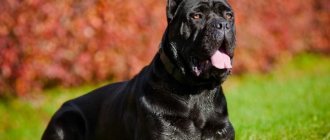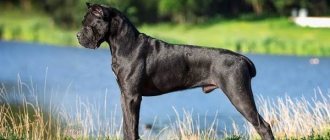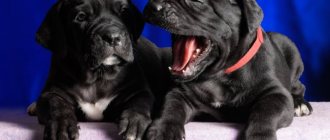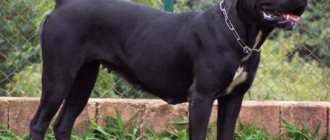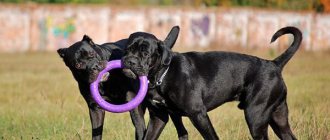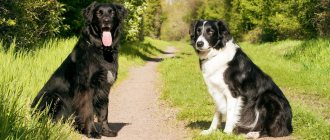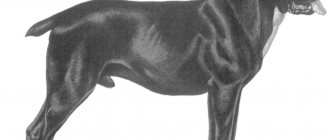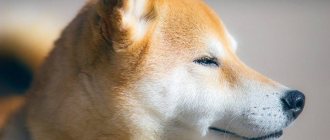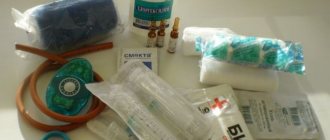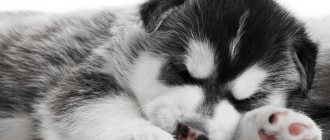Photo: dogfact.ru Cane Corso is a dog for gladiator fights and one of the most ancient breeds in the world. Strong and resilient protectors, reliable working dogs and faithful guards - all these are Cane Corsos. In our latitudes, this amazing breed is not yet so well known, but is gradually becoming more and more popular. So let’s talk about its features and specifics of care!
Description of the Cane Corso breed
Popularity 23rd among 263 dog breeds
Lifespan:
9-11 years
Breed group:
Sentinels
Height:
males: 64-68 cm, females: 60-64 cm
Country of origin:
Italy
Average price:
20-30 thousand rubles
Weight:
males: 45-50 kg, females: 40-45 kg
Latest articles Cat health
Rabies vaccination for cats: choice of vaccine, necessity, schedule 01/22/2022 4 0 0
Selection and adaptation
TOP 20 best cat breeds for families with children 01/22/2022 25 0 0
Advantages and disadvantages
- Pros:
- calm, friendly;
- quick-witted;
- gets along at home without special preparation or preliminary training;
- finds a common language with others;
- possessor of ideal security qualities;
- It is not fussy to care for and does not require daily hassle.
- Minuses:
- excessive salivation;
- long molting time;
- intolerance to low temperatures, it is better not to keep the cane outdoors or in a cage;
- Dog food costs are high;
- requires constant walks, games, physical activities;
- Due to energy, joint disease may develop.
Key facts
The description of the Cane Corso breed says that the dog is an excellent guard, he is endowed with the instinct to protect his own territory. The dog will protect its owner and will not give him offense. The hot Italian blood of the dog will play into your hands at the right moment if a burglar breaks into the house.
This breed is endowed with strength and strong muscles. Corsos are smart, hardy, and energetic. To maintain shape, they need regular strength training. Despite their outward calmness and even carelessness, Cane Corsos are active. Dogs love to play outdoors and participate in marathons. The fiery Italian breed has its origins in herding dogs. Hence, animals retained their kindness and desire to control everyone. Therefore, the pet will be able to look after the children.
Cane Corso owners are very lucky: they are the owners of an ancient breed of gladiator dogs. A noble glow of severity and seriousness seems to emanate from them. Cane Corso have changed over the centuries-old history of their breed, softened their disposition and now easily find a common language even with children.
This breed was bred in hot Italy. The country is proud of dogs for a reason, because the characteristics of the Cane Corso breed almost scream that the animal is a real work of art, and not a dog. Thanks to its sensitive intuition, this breed will serve as a security guard better than any alarm or watchman.
The Cane Corso's lifespan is not very long, but this is considered normal for large breed dogs. In good conditions, an Italian dog will live up to 12-13 years.
History of the origin of the Cane Corso
The interesting history of the breed goes back to ancient times. Harsh times required protection of people, support, and a sense of security. The ancestors of the Cane Corso served as guards against wild animals and surrounding enemies.
The closest ancestor to the type of Cane Corso breed that exists today is the Tibetan Great Dane, bred three thousand years ago. The territory of their origin is now called Eurasia. Perhaps the Cane Corso inherited the burning Italian anger from the Tibetan Great Danes.
Over time, the breed expanded beyond its range and was modified by crossing with other breeds. Most often they were used for defense and attack, and participation in military campaigns, but in China, Tibetan Great Danes participated in dog battles.
Cane Corso has been documented in documents since the 14th-15th centuries. Their service in hunting and fights was described; other individuals were used as shepherds. All this is recorded in the chronicles, but there is an established history of the appearance of Corso dogs as a breed much earlier - the roots go back to the heyday of the Roman Empire. Statues, frescoes, and columns depicting this breed were found in Roman cities. On them, noble, stately dogs faithfully followed their owner, accompanying him on the hunt or sitting majestically at the throne of the emperor.
Nothing lasts forever and the Roman Empire collapsed. The Corso breed has undergone changes - namely, crossing with Celtic greyhounds. The innovation changed the dogs for the better, their character softened, and now Corsos - fighting dogs, the threat of enemies - become guards of animal herds, faithful assistants to farmers.
For many centuries, they tried to preserve the Corso, leaving the optimal genotype unchanged. It turned out that after the outbreak of World War II, the dogs were redirected to service. They carried heavy loads, helped soldiers and civilians, because of which many representatives of the breed died, and malnutrition crippled the ideal genetic chain of dogs. The world did not want to say goodbye to the hardworking animal, and the gap in the development of the breed was patched by Giovanni Banatti Nizzoli.
Having exerted a huge amount of effort, spending time and their own resources, Italian breeders collected purebred Cane Corso dogs and managed to bring them to the ideal level. A standard for purebred dogs appeared.
The description of the external features that distinguish the Cane Corso from other dogs, including non-purebred ones, has been officially established. After the approval of the breed at the global level was completed in 1994, the number of dogs of this breed soared several times.
Appearance of Cane Corso
General impression
This large breed looks like a real fighter dog: strong muscles, strong physique. The dogs look in the best traditions of charismatic and temperamental Italy. They are serious, fast, agile, with an ardent character, and the elegance of their movements is similar to that of a cat. All characteristics are visible in the photo of the Cane Corso. The centuries-old evolution and development of the breed ultimately led to the emergence of better results in terms of appearance and character. Through persistent selection, a powerful, strong breed with a kind heart and devotion to its owner was developed. Isn't this the perfect balance?
Head
The structure of the Cane Corso's skull is average with a slope in width, length is not inherent.
The muzzle is square-shaped with strong bones, short, without skin folds, the skin is stretched over the skull. The eyes are widely spaced from each other, slightly elongated and narrow in shape. Eyelids black. Interestingly, the color of the dog’s eyes also depends on the saturation (darkness) of the dog’s fur.
The ears are covered with shiny soft fur without tassels at the corners. They are large in shape; for better perception of sounds, they are spaced far apart on the head. The ears are wide at the base and narrower towards the end and have a triangular shape.
The lips are compressed, the corners are not lowered. The peculiarity of the structure is that the lower lip covers the upper lip. A wet dog's nose is dark black and oval in shape. Medium in size, voluminous nostrils.
The sharp carnassial teeth of the Cane Corso are adapted for any type of meat. They are strong and number 42 in total. Corso teeth always remain white. Hunter-type jaws with a protruding lower jaw create a slight overbite of the teeth.
Neck
Another example of a combination of grace and strength is the corso neck. It is sculpted, powerful, looks organically with the dog’s body, but at the same time flexible, graceful and noble. The size and length are similar to the length of a dog's head.
Torso
In contrast to body length, the dog's height at the withers is somewhat shorter. The croup is voluminous, while the withers rise above it and are therefore quite noticeable. The Cane Corso is an active dog with lung capacity consistent with a wide chest and well-spaced ribs. The dog's back is prominent, the ribs are not clearly visible.
Limbs
The shoulder blades, adapted for active activities, are connected to the dog's front legs.
There is a strong structure of the entire musculoskeletal system, extraordinary feline grace due to the soft pads on the back of the oval-shaped paws. The muscular hind limbs perform an excellent jumping function thanks to elastic muscles and strong bones. The hips are wide, stand out against the general background, extended towards the spine. Like the front legs, the Cane Corso's hind legs are oval, with protective pads and sharp nails. This structure allows the Cane Corso to cover long distances at high speed without losing the feline flexibility and strength of its ancestors, the Tibetan Great Danes.
Tail
In this breed, the length of the tail reaches the bend line of the hind limbs. Located high on the body, tapering towards the end. The powerful structure of the Cane Corso does not allow it to bend or raise its tail.
Wool
The skin fits tightly over the bones, but does not create a painful appearance. Rough fur structure, short hair, shiny, glossy appearance - an indicator of a pure breed. If otherwise, then this is already a deviation from established norms.
Color
The various colors of the Cane Corso do not fit into one range. These can be standard black, golden-red, striped, ash, dark gray, wet asphalt, red, brick colors. It is not scary if the fur is covered with white spots on the chest or some parts of the body.
Size
The length of the body exceeds the height of the dog (at the withers). On average, the height of Cane Corso in females is 60-65 cm, in males - 61-55 cm. The large structure of fighting dogs corresponds to their weight - from 40 to 50 kg, depending on gender and age. The maximum weight of the Cane Corso reaches 55 kg for particularly powerful representatives of the breed. The size of the Cane Corso suggests that the dog will be given a spacious place in an apartment, or better yet, in a private house.
Weight and height from 1 to 12 months
First
Puppies are actively exploring the world. Become more mobile .
At this age, it is already possible to determine the character of the pet; some become restless and inquisitive, while other puppies, on the contrary, are lazy.
During this period they weigh 6-8 kg . The height of a one-month-old puppy is within 25 cm.
Second
During this period, you can gradually wean the puppy away from its mother and siblings.
The baby's curiosity increases, he needs to stick his nose everywhere.
The weight of a 2-month-old Cane Corso is about 9 kg, height is 32 cm.
Third
At this age, learning ability increases.
In addition to remembering its name, the puppy can master simple commands for action.
A dog at three months already weighs a lot, it’s about 13.5 kg.
Height reaches 42 cm at the withers.
Fourth
During this period, the dog tries to dominate, begins to growl and even bite during the game.
Cane Corso already weighs from 16 to 18.5 kg, grows up to 47 cm.
Fifth-sixth
During this period, the animal is already approaching an adult dog; it is worth continuing to train the breed. The cables show signs of sexual activity. At this age, the dog reaches a weight of 22-29 kg and a height of 55-56.5 cm.
IMPORTANT!
In the first five months, the puppy rapidly gains weight and height. In 4 months, the Cane Corso's height at the withers doubles, and its weight almost triples.
Seventh
A dog at this age asserts itself and sometimes shows its character and stubbornness. Sometimes the commands that the Cane Corso previously carried out willingly, he refuses to carry out.
The weight of a 7-month-old puppy already reaches 25 kg and above, and the height remains within 57-58 cm.
Eighth
At this age, dogs become timid. The once familiar street noise can frighten them.
It is worth being patient and waiting out this period without particularly punishing the Cane Corso.
The weight is already approaching the level of an adult, and this is in the range of 33-40 kg, the dog’s height is 59-62 cm.
Character of the Cane Corso
Due to their strict appearance, many people consider Cane Corsos to be aggressive strangers from distant Italy, with a reserved disposition and severity, but this is not so. In fact, Cane Corsos are kind and devoted dogs, with a sensitive heart and a vulnerable soul.
If you study the family tree of the breed, it turns out that the Cane Corso is an ideal balance of all the qualities of its ancestors. They are not overly large, not limply soft and not so aggressive.
The breed requires regular exercise to maintain a toned body. It is advisable to train the dog, especially since he will like it. Corsos are smart, resourceful and don't mind learning a trick or two.
Dogs of this breed unnecessarily frighten people. Their menacing appearance to others is a sign of an aggressive character. You should know: the Cane Corso does not attack without reason, but closely watches those around him, wanting to protect his owner from possible danger. Cane Corsos are cute, just give them free rein to frolic - especially puppies under one year old. With age, ardent Italians cool down on games and are more relaxed about entertainment, but do not mind sometimes running after the ball.
The severity and strong character of the Cane Corso will be used in protection. At the right moment, they will turn from a good-natured pet into a fierce bodyguard. This is facilitated by a quick reaction and high speed of movement, as well as a muscular physique and a grip of steel. The aggressor will not escape from the strong teeth of the Cane Corso. Therefore, when training a dog to guard the territory, do not forget to teach it the appropriate commands so that it does not inadvertently injure anyone.
Italian Corsos are devoted to their owner to the last. It is difficult to deceive them and distract them from guarding; they stubbornly stand their ground and do not take their eyes off their owner and family. Dogs do not attack immediately, but warn with a special facial expression, so watch out for this.
The dog cannot stand long periods of loneliness and the absence of its owner. It gets to the point where the sensitive Italian dog, bored, stops eating and moving, and may soon die altogether. Corsos are not just dogs, they are family members, best friends. Dogs cannot live without love and attention. A good owner should understand this and not leave his pet for too long throughout his life.
Reviews
Svetlana: “This is my second dog - I’m glad I chose this breed. We live outside the city, so we have no problems with daily walks. She accompanies me everywhere in the yard - she doesn’t like to be alone.”
Nikolay: “I started training Cane Corso when I was 4 months old. Now it is an obedient animal, devoted to family members. There were, of course, problems with training. Zheton only wanted to play and run, but I was still able to raise him into an obedient male.”
Natalya: “A large dog causes problems when living in a city apartment. When walking you have to be alert - your pet does not ignore cats and birds. He eats everything, but it’s much easier to drive him away from the table than a Labrador.”
Education and training
What do you know about the fiery temper of the Italian Cane Corso? He does not strive to be a leader, he is devoted to his owner and is ready to carry out all his commands. Hence the easy learning ability and success in raising and training the Cane Corso. Remember that dogs of this breed are big children, they become attached to their owner once and for all.
If you decide to train your puppy without the help of specialists, remember a few rules:
- Teach your little Corso cleanliness and basic commands: “Ugh!”, “Stand!”, “Sit!”, “Lie down!”, “Come to me!”, “Near!”, “Place!”.
- Take into account the baby’s negative qualities and eliminate them as they grow older.
- Do not raise your hand to the puppy, this will make him angry and cruel towards you and others.
- Entertain your baby Corso with walks, games, and physical exercises.
Encourage your pet's success with treats.
Then the productivity of learning will increase significantly. Give your baby compliments, he loves kind words and in return will do his best to please you for your warm attitude. It is important to know: only the owner should raise a Cane Corso puppy, and no one else. Strangers will make the situation worse. Looking for a Cane Corso? Find your pet from 1 offer Buy
First aid kit
Every loving owner who values and takes care of his dog should always have a first aid kit for an emergency.
What does it include?
Standard kit - iodine, brilliant green, cotton wool, bandages, activated carbon, hydrogen peroxide, boric acid. Analgin will become simply necessary for pain relief and at high temperatures, Vishnevsky ointment will quickly relieve inflammation. veterinary eye/ear drops on hand to treat infections. Tools include a pipette, a thermometer, an enema, nail clippers, tweezers and several syringes.
It is important to remember that even a small cut on a dog's paw needs treatment. There is no need to think that everything will go away on its own.
Health and illness of the Cane Corso
Possible diseases
This breed is prone to hereditary diseases; study your pet's passport before purchasing.
Most often, the Italian dog suffers from congenital hip dislocation. The disease cannot be treated; in extreme cases, the dog has to be euthanized. Even professional dog handlers do not always see this disease in a puppy, especially since there are no ways to predict it. There is always the possibility of an x-ray procedure, but it will not provide 100% insurance. Possible diseases of the Cane Corso:
- allergy;
- stomach upset;
- epilepsy;
- hyperthyroidism;
- eyelid diseases
Reproductive health
The first estrus in females occurs quite late (compared to most breeds) - at 8 months and later. It is considered normal even if the first estrus was noted after a year. There is no point in breeding a dog before 2-3 heats - pregnancy may not occur. Estrus occurs two to three times a year and lasts three to four weeks. If you don't need puppies and have problems finding a male to breed with, you can sterilize your dog. If you want to get a litter, find a partner suitable for your dog and enlist the support of a specialist. The Corso's pregnancy lasts two months, and labor lasts from 6 to 12 hours on average. It is better if the birth of puppies takes place under the supervision of a veterinarian.
Mating
Mating of Cane Corso should take place at 20-22 months of a dog’s life. Puberty comes earlier, at 8-10 months. It is at this time that bitches begin their first heat. By the 20th month, the girl should have her third cycle; 12-15 are considered favorable days for mating, when signs of readiness appear:
- Swollen loop;
- Light bloody discharge;
- Playful behavior.
Corsos are large dogs. For the first time, it is worth inviting a specialist who will help both pets and owners.
The girl is brought to the male, where there should be a lot of free space. The dogs are given 15-20 minutes to get to know each other, after which the female is allowed to mount. The act usually lasts no more than 10 minutes, but pets stand in the castle for a long time ( 30 minutes ). To ensure that the cable does not damage the genitals, it is helped to become comfortable. At this time, the bitch is not allowed to sit down and is supported under the belly.
Repeated mating is organized after 2 days.
Features of feeding and diet
Carne Corso is designed for vigorous activity, physical exercise, and racing - so it burns a large number of calories. But if you don’t run around the park with your pet and take him to lie down on the sofa for company, a problem with excess body weight, disruption of the gastrointestinal tract and musculoskeletal system appears.
Physical activity and a natural diet for your dog will help prevent troubles. If there is a need to switch your Corso to dry food, choose premium food, no less. This is quite expensive, but cheap Cane Corso food is not suitable - allergies or serious problems with the digestive tract may occur.
What to do if your weight is below normal
An underweight dog indicates health problems. The first thing the owner must do is get his pet’s blood and urine tested.
CAREFULLY!
The most common cause of Cane Corso underweight can be worms.
Perhaps deworming was carried out incorrectly, the wrong drug was selected or the timing of the drug was administered.
If helminthic infestation was not detected, then the cause should be sought in a chronic or inflammatory process in the body.
For a dog of this breed, the problem may be related to the liver or intestinal tract . A veterinarian will help solve all these problems.
Another reason for a puppy’s weight loss is improperly selected food. Everything is not as harmless as it seems.
These circumstances may not have the best effect on the animal’s liver, since such foods contain a lot of protein, which negatively affects the puppy’s growing body..
The young liver is not able to process large amounts of protein, resulting in hepatitis and hepatosis.
Some unscrupulous manufacturers produce low-quality food or put synthetic additives in it that cause addiction in the animal.
As a result, food allergies and liver damage develop.
In this case, you should urgently change the dog’s diet and show your pet to a veterinarian to diagnose the dog’s liver and other internal organs..
Care and maintenance
Living in an apartment is quite comfortable for a dog, but it requires two-hour walks every day. A change of environment will make your pet happy and will not let him get bored. During a walk, the relationship between the owner and the dog is improved, diseases of the musculoskeletal system are prevented, metabolism is accelerated, and the nervous system is strengthened.
The Cane Corso's coat is short, hard, and the undercoat is not thick. The need for combing is minimal: only during the molting period is it necessary to remove excess hair every day. Molting occurs twice a year: in spring and autumn.
Inconvenience can be caused by excessive salivation - it can increase in the hot season. If you get used to this, the Cane Corso will seem like a very clean dog. Caring for and maintaining a Cane Corso does not create problems for owners.
The dog does not emit an unpleasant odor, and yet it does not need to be bathed often. Thorough washing 1-2 times a month is enough, the rest of the time it is recommended to use dry shampoos. They will preserve the luxurious appearance of the Cane Corso, protect against infections, and prevent the appearance of parasites.
Dogs are at high risk of contracting ear diseases. You should take care of your ears with a cotton pad: they remove dirt. It is advisable to repeat the procedure 2-3 times a week, then the risk of ear infections will be reduced to a minimum. If the situation worsens, contact your veterinarian.
Don't forget to take care of your Cane Corso's strong teeth. Buy specialized toys for cleaning teeth; dry food is also suitable. Do not let your pet chew on hard objects - they can damage the animal's gums.
To prevent infections, the Cane Corso's eyes are wiped with a cotton pad soaked in a natural chamomile decoction. Also monitor the condition of the pads on the paws, prevent the appearance of cracks, they are a source of infection. To heal cracks, use an antiseptic or wipe with vegetable oil. Contact your veterinarian to prescribe the necessary medications for your Cane Corso based on your dog's weight, age, and health.
Tips for choosing a puppy
This breed of dog is luxurious and expensive, so before you decide to buy a Cane Corso, familiarize yourself with the nuances of the breed, its pros and cons, and maintenance features. Immediately before purchasing, check the puppy’s passport for all the necessary criteria for purebredness and the absence of hereditary diseases. Study the puppy’s parents, take a closer look at the puppy’s character, external signs, and habits. Externally, healthy Cane Corso puppies look energetic, with a strong build and curious eyes.
How to choose a pet
Beginning dog breeders are usually recommended to choose an Italian Mastiff puppy no older than 3 months, since at an older age he allegedly refuses to recognize a new owner. However, many Cane Corso owners disagree with this.
From their own experience, they know that at 5 months and a little later, the pet gets along well with all family members in the new home if they manage to immediately establish contact with it.
Then he chooses the owner himself. Therefore, when purchasing, it is more important to pay attention to other points (especially if in the future you plan to exhibit the dog or use it for mating):
- Compliance with appearance standards. Reasons for culling a Cane Corso (in addition to those noted) are white, cream, chocolate colors, tan marks on any background, light irises and strabismus, depigmentation of the nose and eyelids, a very short tail or its absence, elongated and soft fur. .
- Availability of documents with pedigree, passport with vaccinations. At the same time, it would be good to take a look at the Cane Corso’s parents, find out about their health, and what they are fed. Information about the fate of the offspring is very important. For example, you should avoid buying puppies from a line that already had pups with dysplasia or allergies.
- The baby's health status. This is a traditional examination of the coat and skin, mucous membranes, and pads on the paws for the presence of injuries, diseases, and parasites.
- Puppy behavior. A healthy Cane Corso is characterized by curiosity, activity, courage, and goodwill. If he shows cowardice or aggression, it is better to refuse the purchase. Moreover, an Italian mastiff with such behavior is subject to disqualification according to the standard.
Before buying a Cane Corso, it is advisable to talk with a specialist in this matter. And under no circumstances should you purchase a dog secondhand or from a dubious kennel.
How much does a Cane Corso cost?
The price of a Cane Corso varies greatly, it starts from 150 and goes up to 1000 dollars. The cost depends on the puppy’s health, purebred and physical development. It is possible to purchase a Cane Corso for a low price with a pure line of pedigree, without impurities, but the health of such an individual can be undermined. In the Russian Federation, dogs are purchased for a small price, but this is a matter of luck. It is dangerous to rely on the quality of the breed without having a puppy passport.
To avoid problems, it is advisable to buy a Cane Corso from experienced breeders or in specialized nurseries with all the required documents.
- A middle class puppy can be purchased for between 600 and 800 dollars. Externally, the baby may differ slightly from the ideally pure version of the breed.
- A higher-end puppy will cost you between $800 and $1,400.
- You can buy a presentation breed puppy for no less than $1,400, sometimes the price reaches $2,000. It is worth it - the puppy will have all the relevant documents, ideal appearance, purebred, without hereditary diseases.
Premium class puppies can confidently participate in exhibitions and take prizes.
Experts advise paying the appropriate price rather than trying to sell it on the cheap. Do you like the article? 0
List of suitable nicknames
When coming up with a name for a pet, it is important that it is short (easily pronounced by the owner). Popular for Cane Corso are:
| Boy | Girl |
| Archie | Aina |
| Argon | Molly |
| Bonya | Betty |
| Vinci | Sally |
| Hector | Nancy |
| Django | Ghersi |
| Prince | Irma |
| Tyson | Alice |
| Osman | Barça |
| Theo | Stacy |
| Norman | Sheldy |
| Khaki | Chloe |
In order for an animal to remember its name, it must be mentioned in positive cases, and avoided when punished.
